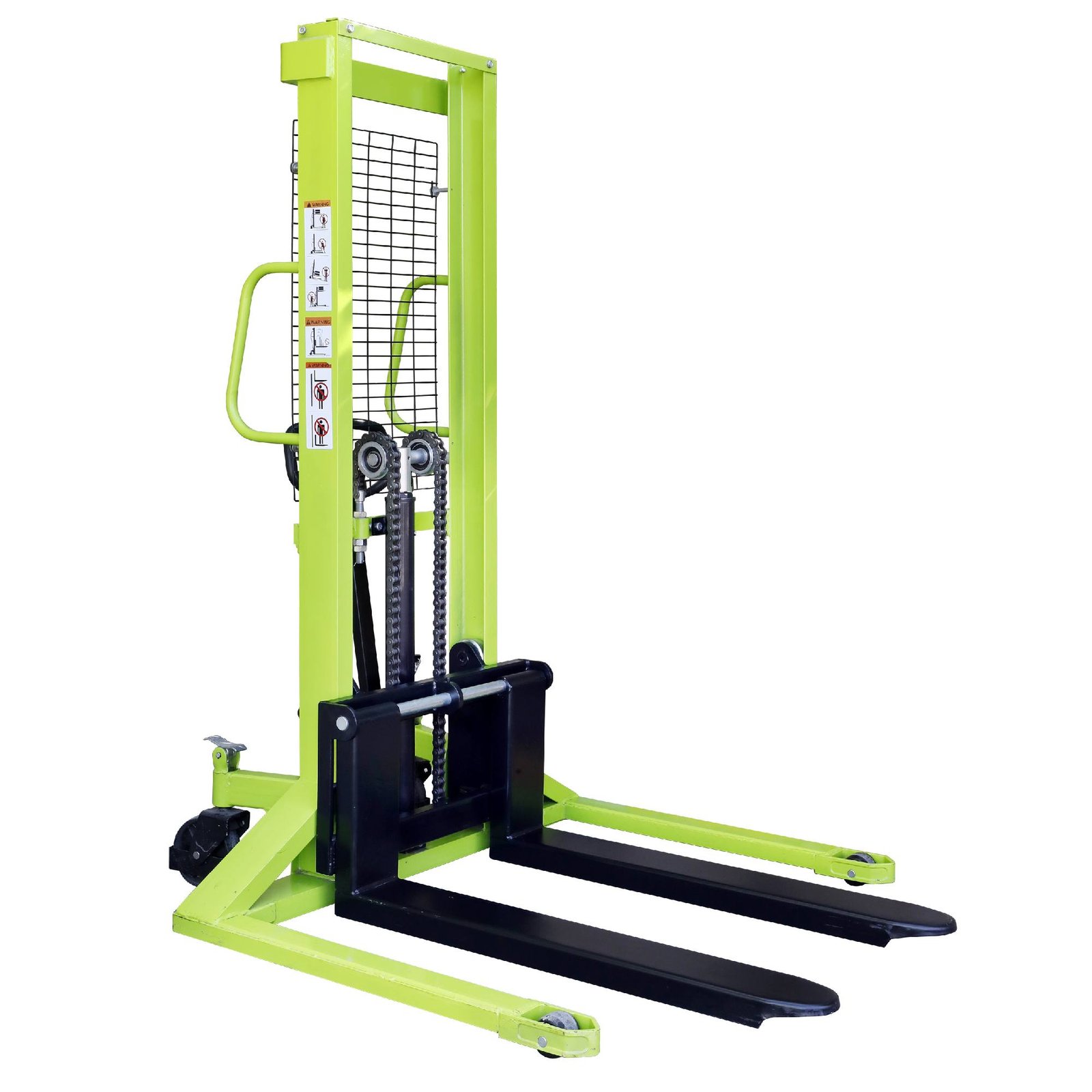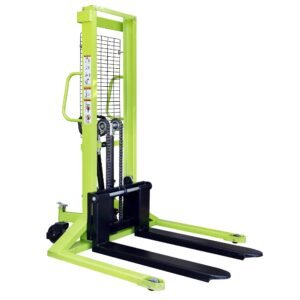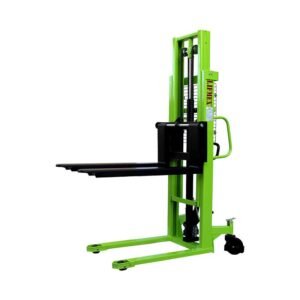Hydraulic stackers are a type of material handling equipment that use hydraulic power to lift and lower loads. They are similar to forklifts, but have some advantages and disadvantages depending on the application. In this blog post, we will discuss the features, benefits, and drawbacks of hydraulic stackers, and how to choose the right one for your needs.
What are hydraulic stackers?
Hydraulic stackers are devices that consist of a mast, a platform, a fork, and a hydraulic cylinder. The hydraulic cylinder is connected to a pump that is operated by a handle or a pedal. By pumping the handle or the pedal, the hydraulic fluid is pressurized and moves the cylinder, which in turn raises or lowers the platform and the fork. The platform and the fork can be used to lift and transport pallets or other heavy loads.
Hydraulic stackers are usually manual, meaning that they are pushed or pulled by the operator. However, some models are semi-electric or fully electric, meaning that they have a battery-powered motor that drives the wheels and/or the hydraulic pump. Electric hydraulic stackers are easier to operate and can handle heavier loads, but they are also more expensive and require regular charging and maintenance.
What are the types of hydraulic stackers?
There are many types of hydraulic stackers available in the market, each with different features and specifications. Some of the common types are:
Extra Wide Hydraulic Hand Stacker
This type of hydraulic stacker has a wider fork and platform than the standard ones, which allows it to handle larger or irregularly shaped loads. It is ideal for loading and unloading trucks, containers, or racks that have wide openings. It is also suitable for handling drums, barrels, or rolls of material. The extra wide hydraulic hand stacker is manual and has a lifting capacity of up to 1.5 tons and a lifting height of up to 1.6 meters.
Hydraulic Hand Stacker
This is the most basic and common type of hydraulic stacker, which has a standard fork and platform size. It is suitable for handling standard pallets or other loads that fit within the fork width. It is also manual and has a lifting capacity of up to 2 tons and a lifting height of up to 3 meters.
Hydraulic Pallet Stacker
This type of hydraulic stacker is designed to handle pallets only.Equipped with a fork that can slide under the pallet and lift it from the bottom, it excels in stacking pallets on top of each other or placing them on racks or shelves. It comes in manual, semi-electric, or fully electric variants, featuring a lifting capacity of up to 2.5 tons and a lifting height of up to 4 meters.
Hydraulic Boom Stacker
This type of hydraulic stacker has a telescopic boom that can extend and retract to adjust the lifting height and reach. Ideal for lifting and placing loads in hard-to-reach areas, such as overhead or behind obstacles, it can also lift and transport people or materials on the boom platform. Typically electric, it boasts a lifting capacity of up to 1 ton and a lifting height of up to 6 meters.
Hydraulic Reel Stacker
This type of hydraulic stacker has a special attachment that can hold and rotate reels or coils of material, such as paper, metal, or plastic. It is ideal for loading and unloading reels or coils from machines or vehicles, or for storing them on racks or shelves. It can be manual or electric, and has a lifting capacity of up to 1 ton and a lifting height of up to 1.6 meters.
Types of Hydraulic Stackers Available
Extra Wide Hydraulic Hand Stacker
GET IT NOW
Hydraulic Hand Stacker
GET IT NOW
What are the benefits of hydraulic stackers?
Hydraulic stackers have many benefits, such as:
– They are easy to use and operate, as they only require pumping the handle or the pedal to lift and lower the load.
– They are versatile and adaptable, as they can handle different types of loads and applications with different attachments and accessories.
– Their economical and efficient operation stems from the fact that they do not require fuel or electricity to operate (except for electric models), and they have low maintenance and operating costs.
– Their safety and reliability result from the inclusion of safety features such as brakes, overload valves, and stabilizers to prevent accidents and damage.
What are the drawbacks of hydraulic stackers?
Hydraulic stackers also have some drawbacks, such as:
– They are heavy and bulky, which makes them difficult to maneuver and transport, especially in narrow or crowded spaces.
– They are slow and labor-intensive, as they require manual effort and time to lift and lower the load, and to move the stacker from one place to another.
– The hydraulic pressure, size of the cylinder, and the mast limit their lifting capacity and height.
– They are prone to leakage and corrosion, as they use hydraulic fluid that can spill or deteriorate over time.
How to choose the right hydraulic stacker for your needs?
To choose the right hydraulic stacker for your needs, you need to consider the following factors:
– The type and size of the load that you need to lift and transport, such as pallets, drums, reels, or other materials.
– The weight and dimensions of the load, such as the length, width, height, and shape of the load.
– The lifting height and reach that you need, such as the maximum and minimum height that you need to lift and lower the load, and the distance that you need to extend or retract the boom or the fork.
– The space and environment that you have, such as the width and length of the aisles, the height and clearance of the doors and ceilings, and the floor and weather conditions.
– The frequency and duration of use, such as how often and how long you need to use the stacker, and how much battery or hydraulic fluid you need.
– The budget and preference that you have, such as how much you are willing to spend and what features and specifications you prefer.
Based on these factors, you can compare and contrast the different types of hydraulic stackers and choose the one that best suits your needs and requirements.
Hydraulic stackers are a useful and convenient type of material handling equipment that can help you lift and transport heavy loads in various settings and situations. However, they also have some limitations and challenges that you need to be aware of and overcome. By understanding the features, benefits, and drawbacks of hydraulic stackers, and by considering the factors that affect your choice, you can find the right hydraulic stacker for your needs and enjoy its advantages and benefits.
For further insights or to discuss your unique requirements, we invite you to connect with us Explore the unparalleled expertise and quality solutions that Shabbir Enterprises brings to the table, ensuring your material handling equipments needs are met with precision and reliability.


